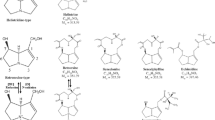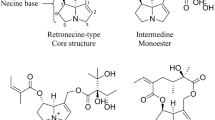Abstract
Pyrrolizidine alkaloids (PAs) and related N-oxides (PANOs) are secondary plant metabolites thought to be found in approximately 3% of the flowering plants worldwide and exhibiting hepatotoxic properties to humans. As a consequence, beehive products are prone to be contaminated with those compounds by bees foraging PA-producing plants. Downstream contamination can also occur through food items containing honey. Analytical methods based on UHPLC separation and MS/MS detection were developed with a focus on very low LOQs and validated for the analysis of 16 PAs and 14 PANOs in honey, honey-based candies and snacks, as well as beehive product–based food supplements. A maximum level of 182 ng/g of PAs was detected in a Mediterranean honey, and high levels of heliotrine-type compounds were reported for the first time. An extensive sampling of honeys harvested in Belgium was performed (N = 374), the concentration levels were more limited with a maximum of 60 ng/g, and the contamination pattern was dominated by senecionine-type PAs. The PA levels in honey-based candies and snacks were very low, with respective maxima of 7.61 ng/g and 0.36 ng/g. Seventy-five percent among the pre-dosed food supplements based on beehive products were contaminated, with a maximum of 43 ng/g. The highest level was detected in a bee-collected pollen sample (1672 ng/g). The analytical results were consistent with the previously reported data for beehive products and confirmed that PA/PANO contamination in these food commodities is recurrent.






Similar content being viewed by others
Notes
Analytical standard of echimidine N-oxide was lacking at the time of validation for the honey method, and this compound has not been targeted in most of the honey samples.
Erucifoline N-oxide exhibited a higher recovery value at the low level (127%).
Seneciphylline N-oxide exhibits a higher CVr value at the low level (43.83%).
Seneciphylline N-oxide exhibits the higher MU at low level, but 27 among the 30 compounds show MU values below 40%.
References
Betteridge K, Cao Y, Colegate SM (2005) Improved method for extraction and LC-MS analysis of pyrrolizidine alkaloids and their N-oxides in honey: application to Echium vulgare honeys. J Agric Food Chem 53:1894–1902
Bobis O, Marghitas LA, Dezmirean D, Bonta V, Mihai CM (2010) Beehive products: source of nutrients and natural biologically active compounds. J Agroaliment Process Technol 16(2):104–109
Bodi D, Ronczka S, Gottschalk C, Behr N, Skibba A, Wagner M, Lahrssen-Wiederholt M, Preiss-Weigert A, These A (2014) Determination of pyrrolizidine alkaloids in tea, herbal drugs and honey. Food Addit Contam Part A 31(11):1886–1895
Boppré M, Colegate SM, Edgar JA (2005) Pyrrolizidine alkaloids of Echium vulgare honey found in pure pollen. J Agric Food Chem 53:594–600
Dai N, Yu Y-C, Ren T-H, Wu J-G, Jiang Y, Shen L-G (2007) Gynura root induces hepatic veno-occlusive disease: a case report and review of the literature. World J Gastroenterol 13(10):1628–1631
Directive 2002/657/EC (n.d.) Commission Decision of 12 August 2002 implementing Council Directive 96/23/EC concerning the performance of analytical methods and the interpretation of results (notified under document number C(2002) 3044)
Dübecke A, Beckh G, Lüllmann C (2011) Pyrrolizidine alkaloids in honey and bee pollen. Food Addit Contam 28(3):348–358
Edgar JA, Roeder E, Molyneux RJ (2002) Honey from plants containing pyrrolizidine alkaloids: a potential threat to health. J Agric Food Chem 50:2719–2730
EFSA (European Food Safety Authority) (2011) Scientific opinion of the EFSA panel on contaminants in the food chain (CONTAM) on pyrrolizidine alkaloids in food and feed. The EFSA Journal 9(11):2406
EFSA (European Food Safety Authority) (2016) Dietary exposure assessment to pyrrolizidine alkaloids in the European Union. The EFSA Journal 14(8):4572
EFSA Panel on Contaminants in the Food Chain (2017) Risk for human related to the presence of pyrrolizidine alkaloids in honey, tea, herbal infusions and food supplements. EFSA J 15(7):4908
El-Shazly A, El-Domiaty M, Witte L, Wink M (1998) Pyrrolizidine alkaloids in members of the Boraginaceae from Sinai (Egypt). Biochem Syst Ecol 26:619–636
Erdtman G (1969) Handbook of palynology. Munksgaard, Copenhagen 486 p
European Commission (2017) Agriculture and rural development. Honey Market Presentation Available from https://ec.europa.eu/agriculture/sites/agriculture/files/honey/market-presentation-honey_en.pdf. Accessed 07/09/2018
European Parliament (2018). Available from http://www.europarl.europa.eu/news/en/headlines/economy/20180222STO98435/key-facts-about-europe-s-honey-market-infographic. Accessed 07/09/2018
Fu PP, Xia Q, Lin G, Chou MW (2004) Pyrrolizidine alkaloids—genotoxicity, metabolism enzymes, metabolic activation, and mechanisms. Drug Metab Rev 36:1–55
Global Industry Analysts, Inc. (2018) Available from https://www.strategyr.com/MarketResearch/infographTemplate.asp?code=MCP-6010. Accessed 07/09/2018
Griffin CT, O’Mahony J, Danaher M, Furey A (2015) Liquid chromatography tandem mass spectrometry detection of targeted pyrrolizidine alkaloids in honeys purchased within Ireland. Food Anal Methods 8(1):18–31
ISO/IEC Guide 98-3:2008 (JCGM/WG1/100). Uncertainty of measurement—part 3: guide to the expression of uncertainty in measurement (GUM:1995). Available for purchase from https://www.iso.org/standard/50461.html
Kempf M, Wittig M, Schönfeld K, Cramer L, Schreier P, Beuerle T (2011) Pyrrolizidine alkaloids in food: downstream contamination in the food chain caused by honey and pollen. Food Addit Contam 28(3):325–331
Langel D (2008) Biosynthesis of the unique necic acid moiety in lycopsamine type pyrrolizidine alkaloid—a molecular approach, Braunschweig Univ., Dissertation, Cuvillier Verlag, Gottingen, pp 9–25
Lucchetti MA, Glauser G, Kilchenmann V, Dübecke A, Beckh G, Praz C, Kast C (2016) Pyrrolizidine alkaloids from Echium vulgare in honey originate primarily from floral nectar. J Agric Food Chem 64(25):5267–5273
Michel R, Raezke KP (2009) Pyrrolizidine alkaloids in honey. Brief overview regarding the occurrence, toxicological effects and risk assessment. Intertek Food Services GmbH, Bremen
Mohabbat O, Shafiq Younos M, Merzad AA, Srivastava RN, Sediq GG, Aram GN (1976) An outbreak of hepatic venoocclusive disease in North-Western Afghanistan. Lancet 308:269–271
Mulder PPJ, Sanchez PL, These A, Preiss-Weigert A, Castellari M (2015) EFSA External scientific report. EN-859 occurrence of pyrrolizidine alkaloids in food. EFSA Supporting Publications, p 116. Available from https://www.efsa.europa.eu/en/supporting/pub/en-859. Accessed 07/09/2018
Neuman MG, Cohen LB, Opris M, Nanau R, Jeong H (2015) Hepatotoxicity of pyrrolizidine alkaloids. J Pharm Pharm Sci 18(4):825–843
Orantes-Bermejo FJ, Serra Bonveh J, Gómez-Pajuel A, Megías M, Torres C (2013) Pyrrolizidine alkaloids: their occurrence in Spanish honey collected from purple viper’s bugloss (Echium spp.). Food Additives & Contaminants: Part A 30(10):1799–1806
Picron JF, Herman M, Van Hoeck E, Goscinny S (2018) Analytical strategies for the determination of pyrrolizidine alkaloids in plant based food and examination of the transfer rate during the infusion process. Food Chem 266:514–523
Premratanachai P, Chanchao C (2014) Review of the anticancer activities of bee products. Asian Pac J Trop Biomed 4(5):337–344
Roeder E (1995) Medicinal plants in Europe containing pyrrolizidine alkaloids. Pharmazie 50:83–98
Roeder E (2000) Medicinal plants in China containing pyrrolizidine alkaloids. Pharmazie 55:711–726
SANTE/11945/2015 (2015) Guidance document on analytical quality control and method validation procedures for pesticides residues analysis in food and feed. Implemented version (SANTE/11813/2017) available from http://www.eurl-pesticides.eu/docs/public/tmplt_article.asp?CntID=727
Tamošiūnas V, Mischke C, Mulder PPJ, Stroka J (2013) Report on the 2012 Proficiency Test on pyrrolizidine alkaloids in honey and hay, Joint Research Centre (JRC), Scientific and Policy Reports. Report EUR 26235 EN. Available from https://ec.europa.eu/jrc/en/publication/eur-scientific-and-technical-research-reports/report-2012-proficiency-test-pyrrolizidine-alkaloids-honey-and-hay. Accessed 07/09/2018
Tandon HD, Tandon BN (1975) Epidemic of liver disease—Gulran District, Herat Province, Afghanistan, Alexandria, World Health Organization, Regional Office for the Eastern Mediterranean (Assignment report No. EM/AFG/OCD/001/RB)
Tandon BN, Tandon RK, Tandon HD, Narndranathan M, Joshi JK (1976) An epidemic veno-occlusive disease of liver in Central India. Lancet 308:271–272
Van Loco J, Beernaert H (2003) An alternative method validation strategy for the European Decision 2002/657/EC. In: Proceedings of Euro food chem. XII: Strategies for Safe food, pp 91–94
Wiedenfeld H, Edgar J (2011) Toxicity of pyrrolizidine alkaloids to humans and ruminants. Phytochem Rev 10:137–151
Acknowledgements
The authors would like to thank CARI asbl (Centre Apicole de Recherche et d’Information) and particularly Mr. Etienne Bruneau for providing the complimentary Walloon honey samples and for the pollen analyses.
Funding
This research was funded by the Belgian Federal Public Service of Health, Food Chain Safety and Environment through the contract RT 14/10 PASFOOD.
Author information
Authors and Affiliations
Corresponding author
Ethics declarations
Conflict of interest
The authors declare that they have no conflicts of interest.
Additional information
Responsible editor: Philippe Garrigues
Publisher’s note
Springer Nature remains neutral with regard to jurisdictional claims in published maps and institutional affiliations.
Electronic supplementary material
ESM 1
(DOCX 608 kb)
Rights and permissions
About this article
Cite this article
Picron, JF., Herman, M., Van Hoeck, E. et al. Monitoring of pyrrolizidine alkaloids in beehive products and derivatives on the Belgian market. Environ Sci Pollut Res 27, 5693–5708 (2020). https://doi.org/10.1007/s11356-019-04499-2
Received:
Accepted:
Published:
Issue Date:
DOI: https://doi.org/10.1007/s11356-019-04499-2




